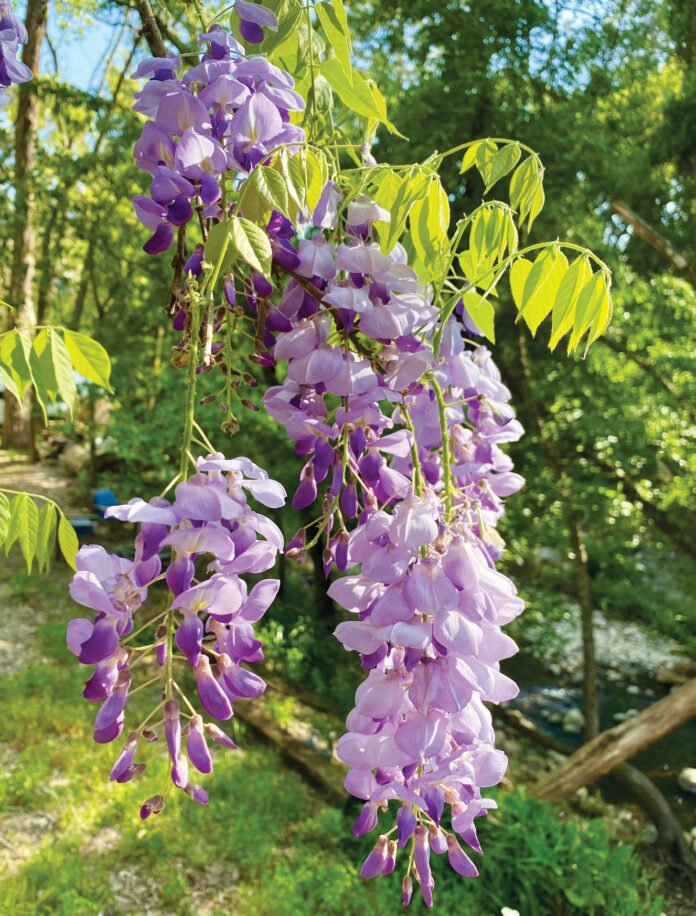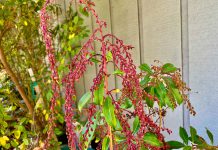Wisteria are one of those vines that you either long for or lament ever having planted. They are all fragrant with a delicious sweet scent that varies from faint to strong to almost overpowering. Bees and hummingbirds love them. Here are some tips to choose and enjoy one in your garden.
Wisteria are one of nature’s most resilient survivors. They are able to withstand and recover quickly from difficult conditions. To some they are a little too tough for their own good with a growth rate rivaling bamboo during the summer. If you dream of a wisteria-covered pergola shading your patio here are some maintenance tips that are sure to keep both gardener and vine happy.
Wisteria are so vigorous they can be pruned at any time, keeping them in bounds and clearing out unwanted or dead growth. Prune out any stems you see extending into eaves, windows or shingles. If yours has gotten away from you, you can even prune it down to the ground and start over with training although you’ll have to wait a few years for your vine to bloom again.
To their control size major pruning is done during the dormant season. Start by trimming the long tendrils that grew over the summer back to about 6 inches from the main trunk. Cutting the tendrils back in this way will initiate flower bud development, neaten the plant up, and show off the attractive trusty, gnarly character of the vines.
Whatever time you do renovation pruning, remember the response of the wisteria to aggressive pruning is to literally explode with new runners. They put energy into new vegetative growth at the expense of flowering. Make sure you keep up on ongoing maintenance pruning by removing all unwanted runners right to their point of origin. Then prune back the others to 3 buds or sets of leaves. Repeated pruning of these runners is what will eventually give you spurs of wood, short laterals that in turn will provide you with flower clusters. You need to prune these runners all season long which ends up being every 3-4 weeks.
Do not fertilize your wisteria. They do not flower well if there is an over abundance of luxuriant growth. Over feeding also ends up giving them the means to become an unmanageable monster. If you have trouble getting your vine to flower an application of a high phosphorus fertilizer may promote blooming.
Maintaining a wisteria requires some diligence, but the reward is worth the effort. Remember this especially during winter pruning season to make summer maintenance easier. If you find that the wisteria vine has invaded a nearby bed, cut roots with a shovel below the soil line to control any that have wandered.
Which variety of wisteria should you get to cover your arbor, pergola, tree or other structure?
Chinese varieties such as “Cooke’s Special” have clusters of fragrant blue-purple flowers 20 inches long. This variety can re-bloom, which makes it a favorite. Chinese wisteria can take up to 20 years to mature enough to produce flowers, but once it has matured, the plant is very long lived and can live up to 100 years.
Japanese wisteria like “Caroline” bloom early with mauve flowers. “Royal Purple,” known also as “Black Dragon,” has sweetly scented dark purple flowers. Japanese wisteria are most effective when grown on pergolas so their long flower cluster can hang freely.
American wisteria, native to more eastern areas of the U.S. is a smaller, less invasive species that grows about a third the rate of Asian wisteria. “Amethyst Falls” blooms at an early age with lightly fragrant purple racemes. Use in containers for porch or patio, train up an arbor or trellis or as a small free-standing tree.
Silky varieties produce a profusion of short, 6 inch, fat clusters of strongly scented flowers that open all at once. They have velvety seed pods and bloom best in full sun.
All parts of the wisteria vine contain a toxin known as wisteria which can cause stomach upset. Growers should also be wary of pets and children eating the flowers or seed pods.
Jan Nelson, a landscape designer and California-certified nursery professional, will answer questions about gardening in the Santa Cruz Mountains. Email her at ja******@*ol.com, or visit jannelsonlandscapedesign.com.














Hi and thank you for this valuable information. We live in northern Colorado. My husband planted a wisteria a few years ago which is now climbing a v shaped line along the fence. Can you tell me more about it if I send a photo? Thank you.